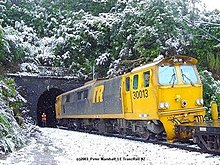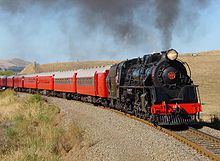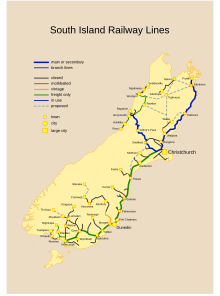Rail transport in New Zealand
The rail transport in New Zealand is a 4,000-kilometer route network in Cape gauge is available that most major cities in the North and the South Island of New Zealand combines. The railway is mainly used for freight traffic, passenger traffic only plays an important role in the metropolitan areas of Auckland and Wellington . Long-distance transport for tourists is offered on a few main routes.
history
Start in the provinces
New Zealand's first ore-only railroad opened in 1861 to transport chrome ore extracted from the Dun Mountain deposit to the port of Nelson City . The expansion of New Zealand's railway network was initially driven by its provinces, a political division of the country between 1841 and 1876, which has merged into the current structure of the regions of New Zealand . New Zealand's first public railroad opened in Canterbury Province in 1863 with the Ferrymead Railway between Ferrymead and Christchurch .
The Canterbury Provincial Railways were built between 1867 and 1876 in a gauge of 1,600 mm (5 '3 "). On February 5, 1867 in the province of Southland, the line between Invercargill and Bluff was built in standard gauge of 1,435 mm (4' 8.5 ") opened. At this point, the central government changed the regulations and set the 1067 mm (3 '6 ") gauge ( Cape Gauge) as the mandatory national gauge. The 1067 mm gauge was chosen to be cheaper to build. The first line in this gauge was the Port Chalmers Branch , which opened on January 1, 1873 in the province of Otago and was operated by the Dunedin and Port Chalmers Railway Company Limited .
Assumption of supervision by the central government
As a result of the abolition of the provinces in 1876, the railways were placed under the supervision of the central government, initially under the administration of the New Zealand Department of Public Works , from 1880 under the responsibility of the New Zealand Railways Department . Furthermore, some railways were privately built, but only the Wellington and Manawatu Railway , which was not nationalized until 1908, achieved noticeable economic success.
The sometimes difficult terrain required numerous engineering structures , for example the Raurimu spiral , a double loop with a roundabout. Around 1787 bridges and 150 tunnels were built. The route network reached its greatest extent in 1952 with around 5700 kilometers and at that time had over 100 operated routes. Much of it was closed in the 1960s and 1970s. The network was originally well protected from direct competition from road transport, but this protection was gradually phased out over the course of the 20th century, eventually being phased out in 1983.
Conversion into a company and privatization
In 1982 the railway was converted from a state to a commercial enterprise, the New Zealand Railways Corporation. It should be profitable. In 1990 the core business of rail operations was transferred to New Zealand Rail Limited , still a state-owned company, while the areas not defined as core business remained in the New Zealand Railways Corporation . New Zealand Rail Limited was sold in 1993 for NZ $ 400 million (EUR 202 million), the new owner changed the name to Tranz Rail in 1995 .
Tranz Rail has been accused several times of shifting rail transports to its own trucks and of forcing the routes to be stopped by failing to maintain the routes. The government security agency ( Land Transport New Zealand ) had doubts, for example. B. 2003 on the operational safety of the Midland Line and identified maintenance backlogs. Funding that was available for road transport was not available to rail operators.
Tranz Rail was also accused of making it difficult for other railway companies, particularly museum train operators, to have adequate access to the rail network.
Renationalization of the railway network
In 2002, Tranz Rail's share price hit an all-time low due to the condition of its facilities and economic results. The government looked at various scenarios to regain access to the rail infrastructure. The main reasons for these considerations were to shift more freight traffic from road back to rail and to ensure access to the route network for other interested railway companies.
The New Zealand state initially bought back the suburban and light rail network of Auckland from Tranz Rail for NZ $ 81 million in 2002. Tranz Rail kept the routes for the freight traffic, while the Auckland Regional Council took responsibility for tendering the public transport of the suburban and light rail network. Responsibility for the railway stations and stops in Auckland that were not already owned by the city council have been transferred to a newly created company, Auckland Regional Transport Network Limited , which is owned by the territorial administration. In 2004, the rail transport services were put out to tender and awarded.
The Toll Holdings of Australia could take over the company first with a successful bid for Tranz Rail. Part of the contract was that the railroad infrastructure was sold to the government for NZ $ 1. The government has since invested approximately NZ $ 200 million in previously neglected maintenance and in the capital increase of New Zealand Railways Corporation. The railway infrastructure company operated under the name Ontrack , while the railway company carried the name Toll Rail .
Since the New Zealand government on the one hand and Toll Rail on the other could not agree on user fees for the nationalized rail network and the state had to raise millions of New Zealand dollars every year for the maintenance of the infrastructure, the government decided in 2008 to to buy back Toll Rail's rail operations for NZ $ 665 million (EUR 336 million) on July 1st. New Zealand Treasury Secretary Michael Cullen said: "The sale of the state railways in the early 1990s and the subsequent decline in assets was a painful lesson for New Zealand".
Accidents
New Zealand's worst railway accident occurred on Christmas Eve 1953 when a lahar , a volcanic mud flow, washed away a bridge at Tangiwai. 151 people lost their lives in the accident when the Wellington-Auckland-Express reached the point shortly after the bridge collapsed and fell into the mud stream. Many of the victims were never found.
The accident outstripped the consequences of the Hyde railway accident on June 4, 1943, in which 21 people died and which is the second most serious railway accident in New Zealand to date.
Railway infrastructure
Owner and operator
After the network was bought back, the government transferred the railway infrastructure to Ontrack Infrastructure Limited, which was founded by the New Zealand Railways Corporation . Ontrack has since been responsible for the development, expansion and maintenance of the New Zealand railway network.
Track systems
The New Zealand railway network has a length of 3898 kilometers, of which around 500 kilometers are electrified . The route network of the North Island and the South Island are not structurally connected. The connection is since 1962 from a ferry made between Wellington and Picton, but which is exclusively for freight.
Extensive corrections were made to the network for a wide variety of reasons. The most important works concerned the Tawa Deviation (Tawa abbreviation) opened in Wellington on June 19, 1937 , the Remutaka abbreviation for the Remutaka Range , which was crossed under a tunnel from November 3, 1955 and since September 12, 1978 the Kaimai shortcut through the Kaimai Range to the Bay of Plenty . These changes were associated with extensive tunnel construction , the latter two each about eight kilometers in length.
Significant infrastructure improvements were made in the mid-1980s along the main route of the North Island, with some sections being electrified. After a few decades of neglect, substantial investments have been made in the Auckland suburban network since the 2000s, with the installation of a second track and other infrastructure improvements.
workshops
Originally a number of large workshops were distributed across the country by the New Zealand Ministry of Railways. operated. The largest workshops were the Addington Workshops in Christchurch (closed in 1990), Hillside Engineering in Dunedin (to Kiwi Rail) and Hutt Workshops in Lower Hutt (belongs to Alstom ).
Railway operations
Both state and private railway companies use the railway infrastructure. The largest rail company is Kiwi Rail, which is part of the state-owned New Zealand Railways Corporation. It was founded in 2008 when the railway operations were nationalized. Veolia (formerly Connex) operates the suburban and urban transport of Auckland.
Types of traction
Until the 1950s, steam locomotives formed the backbone of operations on most routes. The dieselization of traffic began in the late 1940s with shunting locomotives. The first main line locomotive, the DF series , was introduced in 1954. Steam locomotives ended around 1967 on the North Island and 1971 on the South Island.
As early as the 1950s, there were three grids that were electrified with 1.5 kV direct current :
- Wellington suburban traffic
- the route from Christchurch to Lyttelton (electrical systems dismantled today) and
- the section through the Otira tunnel on the Midland Line (from Arthur's Pass to Otira ).
In 1988 the electrification of the North Island Main Trunk Railway (main line of the North Island) between Palmerston North and Hamilton with 25 kV alternating current was completed. The Auckland suburban network is being prepared for electrification. Although there is no prospect of a connection to the electrified network as far as Hamilton, the remaining gap to the south will be relatively small.
Freight transport

After deregulation in 1982, the freight transport facilities were extensively rationalized. Many train stations and smaller loading points were closed and freight traffic accelerated. In 2002, Tranz Rail introduced a very controversial system that envisaged moving most of the freight in containers on corresponding flat wagons in block trains. As a result, container loading systems were built in the larger freight yards.
Freight transport is carried out today by the Kiwi Rail company. Freight traffic makes up by far the largest part of transport. Mainly coal, lime, steel, wood, paper, milk, vehicles, fertilizer, grain and containers are transported. Freight traffic is mainly oriented towards the ports. Coal trains on the Midland Line consist of two locomotives of the DX series and 30 coal hopper cars and a capacity of 1,600 tons per train.
Long-distance passenger transport
During the heyday of passenger rail in New Zealand in the 1950s and 1960s, most regional routes were passenger services. Since the end of 2006 only four long-distance train connections have been operated in New Zealand passenger traffic, today by Kiwi Rail Scenic Journeys :
- The overlander between Auckland and Wellington
- The Capital Connection between Wellington and Palmerston North
- The Coastal Pacific between Picton and Christchurch
- The TranzAlpine between Christchurch and Greymouth
A number of long-distance traffic connections were discontinued when the railway was privately operated (see: here ).
The still existing connections Coastal Pacific on the northern section of the South Island Main Trunk Railway (along the east coast of the South Island) and TranzAlpine on the Midland Line, which crosses the New Zealand Alps, are spectacularly scenic. Despite the growing importance to tourism and marketing, their long-term existence is not guaranteed either. The vehicle material is outdated. It dates from the 1940s and has since been completely overhauled according to requirements.
Metropolitan area traffic

There is local rail passenger transport in the Wellington area . Five lines have been operated by Transdev since July 2016 , all of which are electrified except for the section between Upper Hutt and Masterton . In the 1930s, Wellington was the second city in the country, after Christchurch, to operate suburban trains and is now the only one in the country. Before 2016, Kiwi Rail was the operator with the Tranz Metro division .
For several years Tranz Metro also operated local rail transport in Auckland, New Zealand's largest city. In mid-2004 Connex , later renamed Veolia New Zealand and now Transdev Auckland , won the newly tendered transport contract, whereby Tranz Metro did not submit a bid. Four lines are used, the Southern Line, the Eastern Line, Western Line and, since the end of 2010, the Onehunga Line. All lines run with diesel multiple units or with diesel locomotive-driven trains. There are plans to add new lines to the network and to electrify the existing lines in order to improve the quality of traffic. The first steps in this direction have already been taken with the construction of the new Britomart Transport Center station on Queen Street, right in downtown Auckland.
Traditional / museum business and special traffic

Over 60 different groups operate traditional routes or railway museums in New Zealand . Almost all of them are members of the Federation of New Zealand Railway Organizations. The preservation of the historic railways in New Zealand got a big boost in the 1960s when many steam locomotives were taken out of service and lines were closed.
Railway museums in New Zealand usually focus on the preservation and display of rolling stock over a short stretch of one kilometer on average. A smaller part focuses on the operation of historic trains, usually on disused sections of the former national route network. Large traditional train or museum train operators are:
- the Bush Tramway Club,
- the Glenbrook Vintage Railway ,
- the Goldfield Railway .
- the Mainline Steam Association,
- the Otago Excursion Train Trust Association, whose train runs on the Taieri Gorge Railway and, with a route length of 60 kilometers, is the most ambitious project of its kind today,
- the Railway Enthusiasts Society ,
- the Steam Incorporated ,
- the Waitara Railway Preservation Society and
- the Weka Pass Railway. It operates its own 13 km long route.
Some of the organizations have been running a program of excursions and special trips since 1978, and since 1983 also on the national route network, on which they are allowed to transport their trains with technically suitable locomotives. A small number of other groups of railway enthusiasts have their own historic locomotives and use them there with museum vehicles from other associations or wagons from the regular company fleet.
There is also the Driving Creek Railway , a park and mountain railway with a gauge of 381 mm and a route length of 2.7 km, which operates in the tourist business in Coromandel on the Coromandel Peninsula of the North Island .
literature
- Geoffrey B. Churchman, Tony Hurst: The Railways of New Zealand - A Journey Through History. 2nd Edition. transpress New Zealand, Wellington 2000, ISBN 0-908876-20-3 .
- Geoffrey B. Churchman: New Zealand's Trans-Alpine Express. Schweers and Wall, Aachen 1989, ISBN 3-921679-61-3 .
Web links
Individual evidence
- ^ Ferdinand von Hochstetter: The province of Nelson on the South Island of New Zealand . In: Mittheilungen from Justus Perthes' Geographischer Anstalt about important new researches in the whole field of geography. Born in 1963, issue 1, p. 15
- ↑ a b Reinhard Jellen : The New Zealand state is buying back its railroad. In: Heise-Online, May 9, 2008 . Retrieved February 10, 2011.
- ↑ Unsuccessful privatization - New Zealand nationalizes the railway again. Süddeutsche, May 27, 2010, accessed September 10, 2014 .




